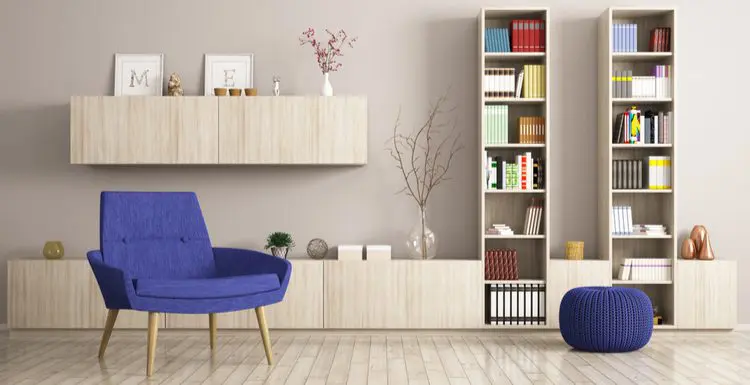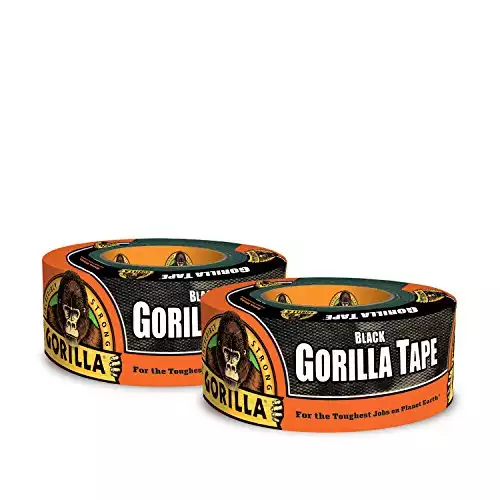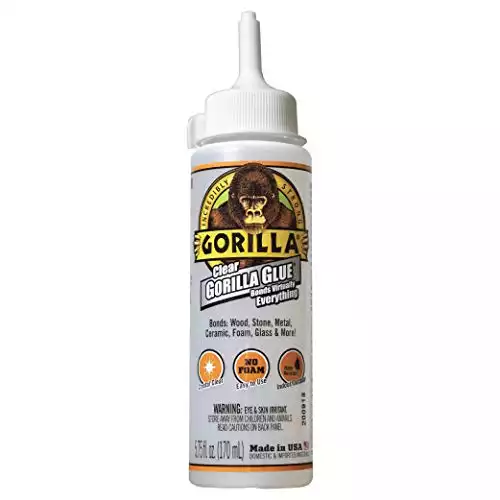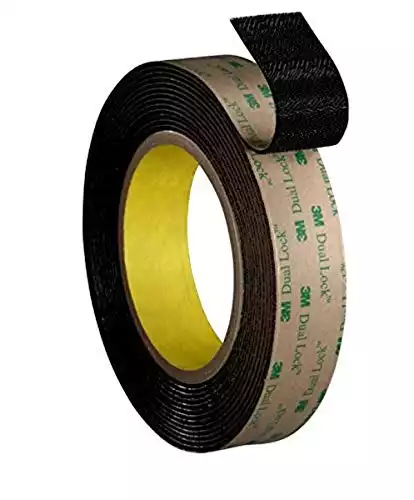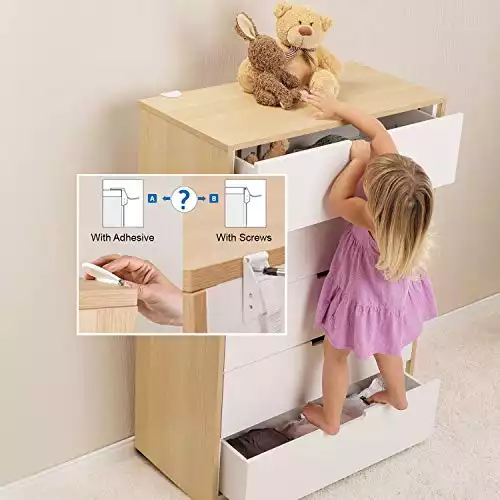If you want to know how to secure a bookshelf to a wall without screws, you have a few different options to do so.
We have examined multiple techniques to attach a bookshelf to a wall without screws and found the three best methods.
However, we should clarify that we always recommend securing any heavy object to the wall using a wall anchor or screw.
How to Secure a Bookshelf to a Wall Without Screws

Urfingus /Shutterstock
Choosing to secure your bookshelf or other heavy furniture can help ensure your and your family’s safety.
Kids, pets, and earthquakes are just a few examples of ways your bookshelf could potentially collapse.
Securing a bookshelf to the wall can give you peace of mind, giving you one less thing to worry about regarding safety.
Using screws to anchor furniture to the wall is one option; however, you can also use:
- Heavy-Duty Glue
- Heavy-DutyTape
- Velcro Strips
- QDOS Safety Anti-Tip Kit
Whether you want to avoid screws to prevent adding extra holes to your wall or want more ease in relocating furniture, these solutions will help you get it done.
Ways to Secure a Bookshelf to a Wall Without Screws
Ensuring that a heavy bookshelf is secure can give you more confidence in your home’s safety, especially if you have curious kids or pets.
1. Heavy-Duty Tape
Using tape is an excellent option for anyone looking to secure a bookshelf to a wall without screws. Many brands produce heavy-duty tapes that do a fantastic job of keeping heavy furniture, like bookshelves, anchored.
When you are ready to move the bookshelf, you can easily take it off the furniture without leaving a mark. The strength of the tape may not be enough to handle kids climbing or dogs knocking into it.
Although most tapes will not withstand heavier weights as screws can, they can be a good option for stability. However, this method is best for lighter-weight bookshelves.
Instructions:
- Determine exactly where you want to place your bookshelf. It can help to use a small pencil mark to guide you.
- Add a little isopropyl alcohol to a cloth and use it to remove oils and dust from the wall and bookshelf. Allow the surfaces about 10 minutes to fully dry. Keeping the surfaces clean will ensure you get the maximum amount of adhesion.
- Press the tape firmly along the backside of your bookshelf. Keep pressure on the tape for about 20 seconds. It can also help to staple the tape to the shelf.
- Remove the protective strip on the backside of the tape to reveal the sticky side. Be careful not to touch the adhesive side to avoid getting any oils.
- Place your bookshelf along the wall where you have marked it with a pencil or plan to sit it. Press the bookshelf against the wall with firm pressure for about 20 seconds.
- Test the strength by gently but firmly pushing the side of the bookshelf. If the bookshelf moves, you may need to repeat the process with new tape.
The instructions above apply to most heavy-duty tapes, though there are other variations where directions may slightly vary.
2. Heavy-Duty Glue
Heavy-duty glue is often a go-to method homeowners use to secure various objects. You can easily find glue brands at reputable stores, such as Home Depot, that work well on multiple surfaces.
Urethane glue will be your best bet for a secure placement. When appropriately applied, urethane glue is strong and should withstand some force.
The only downside to using glue is that some glue may be left attached to the furniture once you decide to move it. In the meantime, if you happen to bump into the bookshelf, it should be strong enough to keep it from tipping.
Instructions:
- Choose the exact location you want to place your bookshelf. Mark the wall with a light pencil to guide you when securing it.
- Use isopropyl alcohol on a cloth and rub it on the wall and bookshelf to clean their surfaces. Allow it to dry for about 10 minutes.
- Apply the urethane glue along the backside of the bookshelf, where you will be anchoring it to the wall.
- Use your guide to press your bookshelf into place firmly. Apply pressure for about one minute to give the glue plenty of time to bond.
- Use masking tape to add pressure while the glue cures. Place the tape on the wall, tightly tape the bookshelf against the wall, and continue to the other side. Use at least four pieces of masking tape, evenly spaced from top to bottom. You may need more strips of tape for a larger bookshelf.
- Allow the glue to cure for about 24 hours, and then remove the tape.
3. Velcro Strips
Some kits include Velcro strips for furniture, or you can use Velcro strips from your local hardware store.
Velcro strips make an excellent no-screw option if you plan on moving furniture later on. Unlike glue or tape, Velcro can be somewhat easier to work with when moving furniture around.
Instructions:
- Use a pencil to mark where each shelf will line up on the wall.
- Thoroughly clean both the wall and bookshelf with a cloth containing isopropyl alcohol.
- Add one side of the Velcro to the wall. Line them along where the vertical edges of the bookshelf will be. Then, add as many strips as needed where each shelf will be. Press into each strip firmly.
- Repeat step three on the bookshelf, adding the other side of the Velcro in the same location.
- Put your bookshelf near the wall to ensure all of the Velcro lines up. Allow the strips at least an hour to fully secure.
- Push the bookshelf against the wall, pressing where you placed Velcro in each location.
4. QDOS Safety Anti-Tip Kit
The Qdos Safety Anti-Tip Kit is a patent-pending system to help secure heavy furniture to prevent accidents or damage. It is a relatively inexpensive kit to purchase and claims to support up to 200 lbs.
You can opt to use adhesive or screws, which the kit will include. If you choose to use the brackets, the hole will be much smaller than a standard screw.
With the Qdos Safety Anti-Tip Kit, you can easily adjust the straps that anchor your furniture to the wall. Because of the easy adjustment, you can temporarily move your bookshelf to clean or grab items that have fallen behind them.
This kit makes a great option to use in kids’ rooms because of its durability and ease of use. When you are ready to remove the kit to move furniture, you can easily do that.
Refer to the included instructions to determine the best place for the attachments for the best results.
What to Consider When You Secure a Bookshelf to the Wall Without Screws
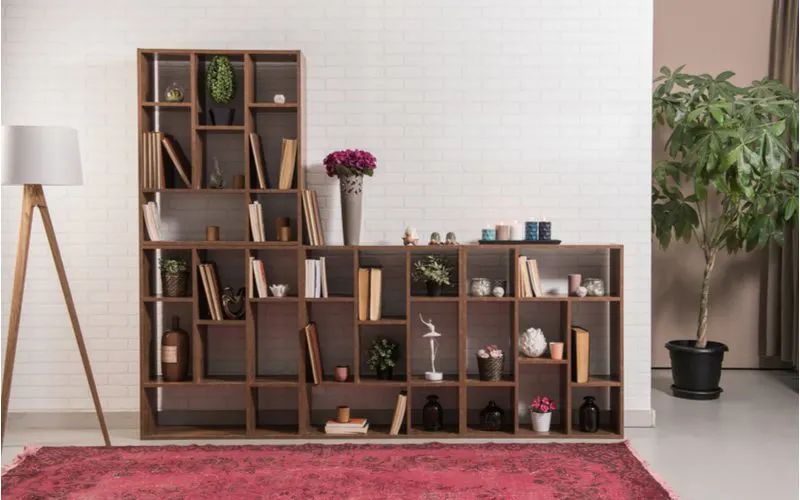
United Photo Studio/Shutterstock
To further ensure the safety of your home, there are a few things to keep in mind when you secure a bookshelf to the wall without screws:
- Be sure you are happy with the location before anchoring your bookshelf.
- If you have heavy carpeting, you can make the bookcase more stable by pulling back the carpeting and nailing a wooden shim to the floor at the position of each of the feet.
- A bookshelf is more likely to wobble when it’s top-heavy. You can prevent this by setting most of the weight on the lower shelves.
- For best results, be sure to thoroughly clean any surfaces you will use to secure the bookshelf to the wall before doing so.
Frequently Asked Questions
Here are some of the most common questions regarding securing a bookshelf to a wall without screws.
Do Bookcases Need to Be Fixed to the Wall?
If you live in an area without earthquakes and do not have kids or pets, it is not necessary to anchor your bookshelf or bookcase to the wall. However, if a bookshelf falls over, it can cause harm to small children or pets.
Even without curious paws or hands, living in locations with frequent earthquakes can pose a risk to you or anyone in your home during one. Though it is unnecessary, adding extra safety precautions doesn’t hurt.
How Do You Keep a Bookshelf From Falling Over?
The best way to keep a bookshelf from falling over is to secure it to the wall. There are multiple methods to anchor heavy furniture to the wall and keep them from tipping over, including glues, tapes, Velcro, and various safety kits.
Which Glue Is Best for the Wall?
Polyurethane or urethane glue is the best glue for a wall. One of the best attributes of polyurethane or urethane glue is that it adheres to multiple surfaces, whether they are porous or nonporous.
This type of glue is waterproof and you can use it for both indoor and outdoor projects.
How Do You Balance a Bookshelf?
Use a level to determine if your bookshelf is balanced. If it is not, ensure that each side of the bookshelf contains about the same amount of weight. Securing a bookshelf using glue, tape, or safety kits can keep it anchored in place, thus keeping it balanced.
When Should You Anchor Heavy Furniture?
If you have kids climbing on furniture, own playful pets, or live in an earthquake zone, it is essential to secure heavy furniture as soon as you can. You may feel like anchoring heavy furniture, such as a bookshelf, is not necessary and can wait to be done.
However, the sooner you secure a bookshelf to the wall, the sooner you can feel more protected. You never know when disaster will strike, so it is always better to take necessary precautions.
Can you Anchor a Bookshelf to Wall Without a Stud?
When securing a bookshelf to the wall using screws, a stud is an important part of the process. Screwing heavy furniture into drywall can not hold up as well but can destroy your wall in the process.
Luckily, you have options to secure a bookshelf to the wall without screws or studs. We suggest using heavy-duty tape, heavy-duty glue, Velcro strips, or a no-screw anti-slip kit when anchoring a bookshelf to the wall without a stud.
Why Is My Bookshelf Leaning?
If your bookshelf is leaning, it may be possible that a leg is too short. It may also be possible your home has an uneven floor which is not only unsightly but can be dangerous.
You can use leveling shims (you can find them in any hardware store) to help balance the bookshelf out and keep it at an even height.
If you plan on securing your bookshelf to your wall, be sure to include the shims before doing so. The last thing you want to do is secure a bookshelf that looks off.
So, How Do You Secure a Bookshelf to a Wall Without Screws?
There are many ways to secure a bookshelf to a wall without screws, but before you do all that, ensure that it is necessary for your family’s safety.
It’s also important to make sure you’ll be happy with its placement. You can use glue, tape, Velcro, or purchase anti-slip safety kits.

